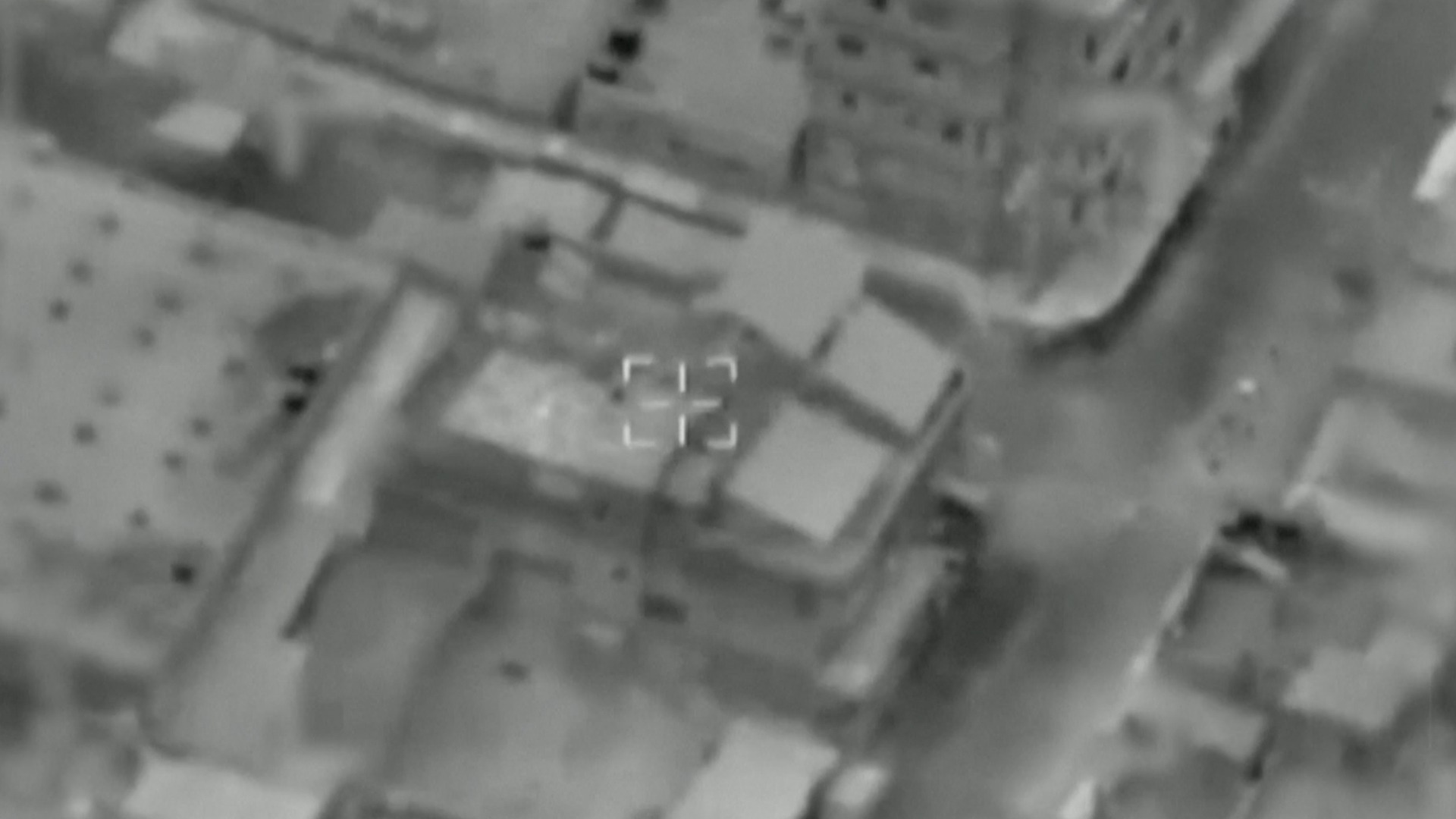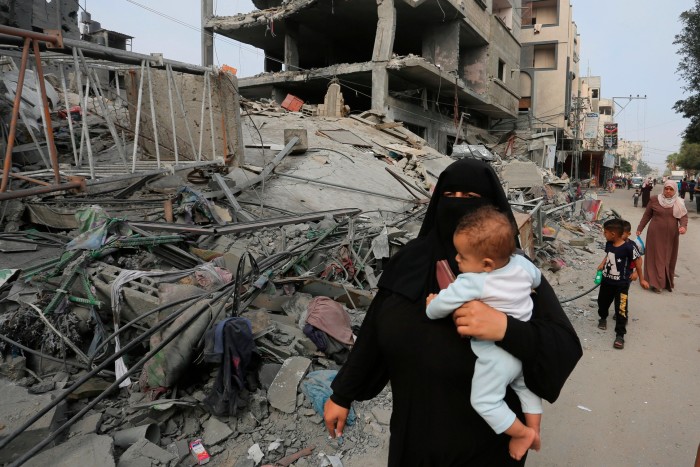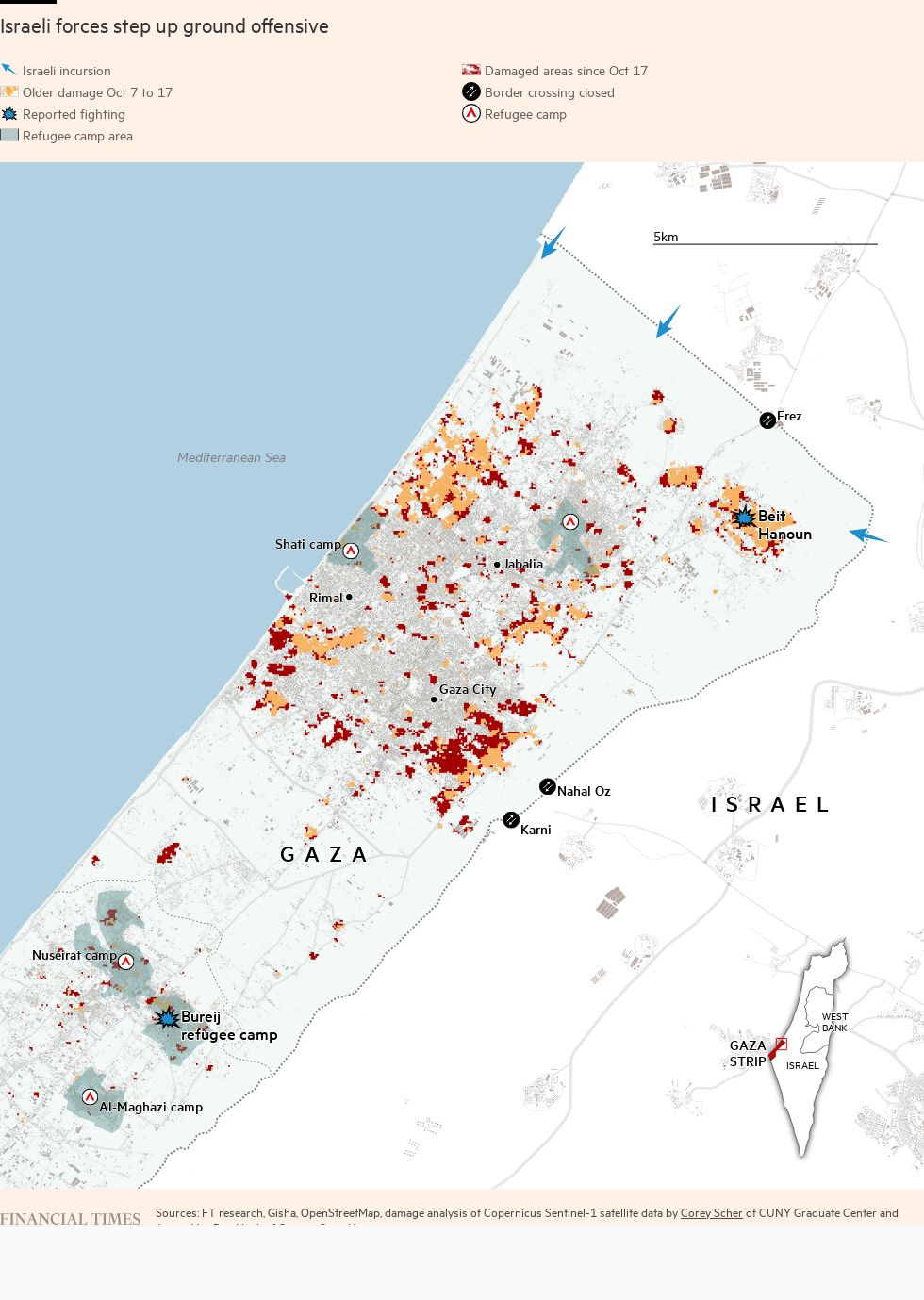Israel said its Gaza offensive was “advancing” after fighting through the night in a significantly expanded ground operation under the cover of an intense aerial bombardment that has knocked out most communications in the enclave.
The Israeli army’s fourth big incursion into Gaza this week appears to be its largest yet. On Saturday military spokesman Rear Admiral Daniel Hagari described it as “advancing in the phases of the war”.
In earlier raids, including one by naval commandos, Israeli troops withdrew within hours. This time they appear to still be within the northern edges of the Gaza Strip the day after entering.
Hamas said it had engaged the Israeli military near Beit Hanoun, north of Gaza City.
The incursion was accompanied by the largest aerial bombardment since hostilities began three weeks ago. Israel also knocked out communications within the Gaza Strip, with cell phone, internet and landline connections lost late on Friday night.
“IDF forces entered the northern Gaza Strip and expanded the ground operations,” said Hagari. “Infantry, armoured, engineering and artillery forces that are accompanied by heavy fire are taking part in this operation.”
UN chief António Guterres reiterated his appeal for “an immediate humanitarian ceasefire, together with the unconditional release of hostages and the delivery of relief”.
He added: “I was encouraged by what seemed to be a growing consensus for the need of at least a humanitarian pause in the Middle East. Regrettably, instead I was surprised by an unprecedented escalation of bombardments, undermining humanitarian objectives. This situation must be reversed.”
The Saudi foreign ministry said it “denounces the ground operations by the Israeli army in Gaza”.
At a rally in Istanbul, Turkish president Recep Tayyip Erdoğan said that Hamas, which has political offices in Qatar and in Turkey, was “not a terrorist organisation . . . Israel is an occupier”.
“We will tell the whole world that Israel is a war criminal,” he told hundreds of thousands of supporters.
Israeli defence minister Yoav Gallant vowed to press on. “Last night the ground shook in Gaza. We attacked above and below ground,” he said. “The instructions to the troops are clear: the operation will continue until further orders.”
Video released by the IDF showed dozens of tanks operating within the perimeter fence that runs along the northern and eastern edges of the Gaza Strip, and alongside the Mediterranean Sea. Hagari did not say if they encountered heavy resistance, nor how deep into Gaza they had advanced.

One frame showed tanks near what appears to be the village of Beit Lahia, at the edge of the Jabalia refugee camp, which is usually densely populated. Israel has repeatedly ordered Palestinians to flee south, ahead of an anticipated ground operation that will probably focus on Gaza City.
It is unclear how many civilians remain in the north.
Abu Mohamed, a resident of the al-Shati refugee camp along the Mediterranean, said: “What happened is beyond description. They killed families, children and women with air strikes, artillery shelling and from boats. They committed horrible massacres and cut off communications so no one would hear us.”
The expanded offensive came days after Benjamin Netanyahu, Israel’s prime minister, said his government was preparing a ground invasion of Gaza. As well as needing time to train reservists, operations were also delayed to allow the US time to move more military assets into the region.
It remained unclear on Saturday whether the intensification of military operations was the prelude to a wider war.
Amos Yadlin, a former head of Israel’s military intelligence, said Friday night’s operation signalled the beginning of the invasion.
“It started last night, even though not in the full scale — it’s a low intensity conflict,” he said. “It is not a blitzkrieg. It is inch by inch, metre by metre.”
The IDF said it had hit 150 Hamas targets overnight, describing them as tunnels, combat spaces and underground infrastructure. It added that it had also killed Asem Abu Rakaba, believed to be the head of Hamas’s aerial array that launched paragliders in the October 7 attack on Israel.
The communications blackout has made it difficult to update death tolls and for ambulances to tend to the wounded. The World Health Organization and Médecins Sans Frontières have lost contact with their teams.

At least 7,650 people have been killed in Israeli air strikes, according to Palestinian officials. More than 1,400 people were killed in Israel by Hamas militants in the raid on October 7, according to the government, with 222 being held hostage.
Some images on social media showed large plumes of smoke along the northern Gaza Strip and exchanges of fire. One person reached briefly by phone said the gunfire was continuing into the late morning.
Phillipe Lazzarini, the head of UNRWA, the UN agency that provides aid to Palestinian refugees, said public services and civil order in the territory, home to 2.3mn people, were collapsing.
Israel has blocked humanitarian aid from entering Gaza, allowing only a few trucks each day that the UN and other agencies said were inadequate for the hundreds of thousands seeking refuge.
“Our aid operation is crumbling and for the first time ever, [UN staff] report that now people are hungry,” Lazzarini said.
Ishaq Sidr, Palestinian minister of telecommunications and information technology, told Palestine TV that Israeli warplanes had attacked telecoms infrastructure that included two points of contact with the outside world.
He said this was having a severe impact on ambulance services in the enclave and had stopped Gazans from transmitting and documenting Israeli attacks in real time. Human rights agencies echoed his concerns.
Additional reporting by Mai Khaled in Rafah and Andrew England in London



